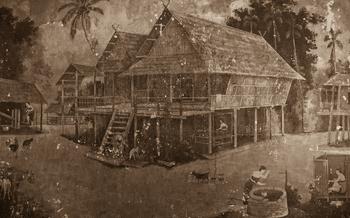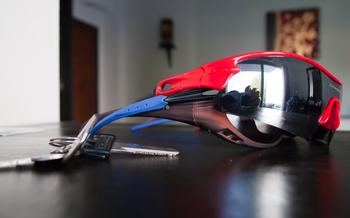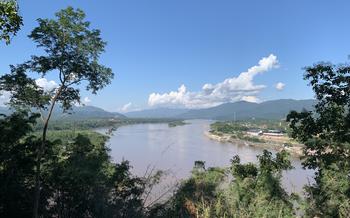
Wat Phra That Chom Chaeng
- Wat Phra That Chom Chaeng: A Sacred Mountaintop Temple
- The Majestic Stupa: A Symbol of Faith and Devotion
- The Grand Staircase: A Path to Enlightenment
- The Emerald Buddha Image: A Revered Relic
- The Surrounding Temples and Chapels: Exploring Hidden Treasures
- The Local Markets: A Feast for the Senses
- The Hill Tribe Villages: A Glimpse into Indigenous Cultures
- Location and Accessibility:
- Cultural Traditions and Lifestyles:
- Opportunities for Interaction and Cultural Exchange:
- Respecting Local Customs and Etiquette:
- The Natural Beauty of Phrae: A Haven for Nature Lovers
- Local Festivals and Events: A Celebration of Culture
- Accommodation Options in Phrae: A Range of Choices
- Transportation to Phrae: Getting There and Around
- Insider Tip: Unveiling a Hidden Gem
Wat Phra That Chom Chaeng: A Sacred Mountaintop Temple
Perched atop a scenic hill, Wat Phra That Chom Chaeng stands as a testament to the deep-rooted spiritual heritage of Phrae. Its history dates back to the 13th century when it was constructed under the reign of King Ramkhamhaeng the Great. The temple holds immense religious significance, serving as a pilgrimage site for devout Buddhists from across the country. The unique architectural features and design elements of Wat Phra That Chom Chaeng reflect the blend of Lanna and Sukhothai architectural styles. The temple complex exudes an aura of tranquility and serenity, inviting visitors to immerse themselves in its spiritual ambiance. The highlight of the temple grounds is the stunning panoramic view overlooking the surrounding countryside. From this vantage point, visitors can witness the breathtaking beauty of Phrae's natural landscapes, a sight that leaves an unforgettable impression.
The Majestic Stupa: A Symbol of Faith and Devotion
Standing tall and proud atop the hill, the majestic stupa of Wat Phra That Chom Chaeng is a sight to behold. Towering at an impressive height, it dominates the skyline and serves as a beacon of faith and devotion for Buddhists from far and wide. The stupa's architectural features are a testament to the skill and artistry of ancient craftsmen. Its intricate carvings and decorative elements showcase the rich cultural heritage of Thailand.
The stupa holds immense religious significance as it is believed to enshrine relics of the Lord Buddha. These sacred relics, which are said to possess great spiritual power, attract countless pilgrims who come to pay homage and seek blessings. The stupa's design incorporates symbolic elements that represent the Buddha's teachings and the path to enlightenment. Its graceful curves and tapering shape symbolize the impermanence of all worldly things and the ultimate goal of achieving nirvana.
The stupa's architectural design is a harmonious blend of traditional Thai and Mon influences. Its bell-shaped dome, adorned with intricate stucco work, is reminiscent of the classic Thai style. The square base, with its four projecting niches, is a nod to the Mon architectural tradition. The combination of these elements creates a unique and visually stunning structure that is both awe-inspiring and spiritually uplifting.
The Grand Staircase: A Path to Enlightenment
The majestic staircase leading up to Wat Phra That Chom Chaeng is not merely a physical structure but a profound symbol of the journey to nirvana in Buddhism. With 306 steps carved into the mountainside, each step represents a stage in the path towards enlightenment, reminding pilgrims of the need for perseverance and dedication on their spiritual quest.
The staircase itself is a testament to architectural ingenuity, showcasing intricate designs and patterns that reflect the artistry and craftsmanship of its creators. The balustrades lining the staircase are adorned with mythical creatures and auspicious symbols, adding to the spiritual significance of the ascent.
Climbing the staircase is an experience that blends physical exertion with spiritual reflection, as pilgrims chant mantras and prayers with each step they take. The gradual incline represents the challenges and obstacles one must overcome on the path to enlightenment, while the breathtaking views from the staircase offer a glimpse of the serenity and peace that await those who persevere.
The summit of the staircase leads to the main temple grounds, where pilgrims can pay homage to the sacred stupa and receive blessings from the resident monks. The sense of accomplishment and spiritual fulfillment upon reaching the top is palpable, making the climb a truly transformative experience for many visitors.
The Emerald Buddha Image: A Revered Relic
Among the many sacred relics housed within Wat Phra That Chom Chaeng, the Emerald Buddha image holds a particularly revered position. This exquisite statue, crafted from a single block of precious green jade, is believed to date back to the 15th century and is considered one of the most significant Buddha images in Thailand.
Standing approximately 45 centimeters tall, the Emerald Buddha exudes an aura of serenity and spiritual power. Its unique iconography and intricate detailing set it apart from other Buddha images, attracting countless pilgrims and devotees from around the world. The statue is adorned with elaborate gold jewelry and precious gemstones, further enhancing its sacred status.
The Emerald Buddha is not only an object of religious devotion but also a symbol of Thai national identity and unity. It is believed to bring good fortune and prosperity to the kingdom, and its presence at Wat Phra That Chom Chaeng is a source of great pride and reverence for the Thai people.
Throughout the year, the Emerald Buddha is adorned with different sets of elaborate robes and jewelry, reflecting the changing seasons and festivals. These adornments are carefully selected and changed by a team of royal officials, adding to the mystique and grandeur of the sacred image.
Pilgrims and visitors alike flock to Wat Phra That Chom Chaeng to pay homage to the Emerald Buddha, seeking blessings, good fortune, and spiritual guidance. The temple often hosts special ceremonies and festivals dedicated to the revered relic, attracting large crowds of devotees and creating a vibrant and spiritual atmosphere.
The Surrounding Temples and Chapels: Exploring Hidden Treasures
Beyond Wat Phra That Chom Chaeng, the temple complex encompasses a network of smaller temples and chapels, each with its unique charm and significance. Wat Chom Thong, located at the foot of the mountain, is renowned for its intricate murals depicting scenes from the Buddha's life. Wat Klang, situated in the heart of the complex, houses a collection of ancient Buddha images, including the revered Phra Chao Tan Jai. Wat Nang Phaya, perched on a hilltop, offers breathtaking views of the surrounding countryside, while Wat Phrathat Doi Suthep, with its gleaming white chedi, is a popular destination for pilgrims and tourists alike.
Exploring these hidden gems allows visitors to delve deeper into the spiritual and cultural heritage of Phrae. Each temple possesses its own unique story, waiting to be discovered by curious travelers. The tranquil atmosphere of these sacred spaces invites contemplation and reflection, providing visitors with a profound sense of peace and serenity.
The Local Markets: A Feast for the Senses
In the heart of Phrae's bustling city, nestled amidst the vibrant streets, lie a labyrinth of local markets, each a treasure trove of unique finds and culinary delights. The morning market, a symphony of colors and aromas, beckons visitors with its array of fresh produce, exotic fruits, and fragrant flowers. Here, the locals barter and trade, creating a lively atmosphere that captures the essence of Phrae's vibrant culture.
As the sun rises higher, the night market comes alive, transforming the city into a kaleidoscope of lights and sounds. Stalls adorned with colorful lanterns and twinkling fairy lights line the streets, offering an eclectic mix of handicrafts, souvenirs, and local delicacies. The air fills with the enticing aroma of grilled meats, sizzling seafood, and sweet treats, tempting visitors to indulge in the culinary delights that Phrae has to offer.
Bargaining is an integral part of the market experience in Phrae. Locals and tourists alike engage in friendly negotiations, adding an element of excitement to the shopping experience. Be prepared to haggle and don't be afraid to ask for a lower price. However, remember to do so with respect and politeness, as the vendors are often friendly and welcoming.
Beyond the bustling markets, visitors can explore the hidden gems of Phrae's culinary scene. Local restaurants and food stalls serve up tantalizing dishes that showcase the unique flavors of Phrae cuisine. From the spicy and sour nam prik num, a fiery chili dip, to the refreshing and aromatic khao soi, a coconut-based noodle soup, there's something to satisfy every palate.
Whether you're a seasoned foodie or simply seeking a taste of local life, the markets and restaurants of Phrae offer a culinary adventure that will leave you wanting more. Immerse yourself in the vibrant atmosphere, engage with the friendly locals, and savor the tantalizing flavors that make Phrae a culinary haven for both locals and visitors alike.
The Hill Tribe Villages: A Glimpse into Indigenous Cultures
In the serene embrace of Phrae's natural beauty, discover a captivating tapestry of diverse hill tribe communities. These indigenous groups, with their vibrant traditions and intricate way of life, invite you on a cultural journey like no other. Nestled amidst the lush hills, their villages offer a glimpse into a world untouched by modern influences, where ancient customs and beliefs still thrive.
Location and Accessibility:
The hill tribe villages are scattered across the mountainous regions of Phrae, each with its unique charm and identity. Some of the most accessible villages include those of the Karen, Hmong, and Lahu tribes, located just a short drive from the city center. Guided tours are available, providing transportation and ensuring a hassle-free experience.
Cultural Traditions and Lifestyles:
As you step into these villages, prepare to be captivated by the kaleidoscope of cultures that unfolds before you. The Karen, known for their intricate textiles and vibrant attire, will welcome you with warm smiles and open hearts. The Hmong, masters of silver crafting and embroidery, will showcase their exquisite handiworks, each piece a testament to their artistic prowess. The Lahu, with their deep connection to nature, will share their knowledge of traditional medicine and sustainable farming practices.
Opportunities for Interaction and Cultural Exchange:
Cultural exchange is not merely a concept here; it's a way of life. Engage in lively conversations with the villagers, learn about their customs, and participate in their daily activities. Whether it's weaving a colorful tapestry with the Karen women, learning the art of silverwork from the Hmong artisans, or joining the Lahu in their farming rituals, each interaction offers an unforgettable glimpse into their rich heritage.
Respecting Local Customs and Etiquette:
As you immerse yourself in these vibrant communities, it's essential to be mindful of local customs and etiquette. Dress modestly, seek permission before entering homes or taking photographs, and always show respect for the elders and religious beliefs. Your sensitivity and understanding will ensure a harmonious and enriching experience for both you and the villagers.
The Natural Beauty of Phrae: A Haven for Nature Lovers
Phrae's natural beauty is a symphony of verdant landscapes, scenic viewpoints, and tranquil havens. Surrounded by rolling hills, lush forests, and sparkling rivers, the province offers a sanctuary for nature enthusiasts and adventure seekers.
Lace up your hiking boots and embark on a journey through the province's diverse terrain. Explore the lush forests and admire the cascading waterfalls, each offering a unique spectacle of nature's artistry. Along the way, keep an eye out for exotic wildlife, including colorful birds, playful monkeys, and even the elusive gibbon.
For those seeking tranquility, Phrae's serene lakes and rivers provide the perfect escape. Cast your line and try your luck at fishing, or simply relax on the banks and soak in the tranquility of the surroundings.
As the sun dips below the horizon, find a secluded spot to witness the sky transform into a canvas of vibrant colors. The sunset views from Phrae's many viewpoints are simply breathtaking, offering a perfect ending to a day of exploration and adventure.
So, whether you're an avid hiker, a nature lover seeking serenity, or simply looking to escape the hustle and bustle of city life, Phrae's natural beauty awaits your exploration.
Local Festivals and Events: A Celebration of Culture
Phrae comes alive during its many festivals and events, showcasing the rich cultural heritage and traditions of the region. The most notable event is the Phrae Lanna Festival, held annually in February or March. This colorful festival features grand processions, traditional performances, and a vibrant night market, offering a glimpse into the unique Lanna culture.
Another highlight is the Kham Muang Festival, held in April or May. This festival celebrates the local hill tribe culture, with traditional dances, music, and food from various ethnic groups. Visitors can experience the diverse traditions of the Karen, Hmong, and Lahu tribes, gaining insights into their way of life.
For those interested in religious festivals, the Wat Phra That Chom Chaeng Fair is a must-see. Held annually in November or December, this fair attracts thousands of pilgrims and visitors to pay homage to the sacred temple. The fair features religious ceremonies, cultural performances, and a lively market, creating a festive atmosphere.
To plan your trip around these events, check local tourism websites or consult with your accommodation or tour operator. Immerse yourself in the local culture, embrace the vibrant atmosphere, and create lasting memories of your visit to Phrae.
Accommodation Options in Phrae: A Range of Choices
Phrae offers a diverse range of accommodation options to suit different budgets and preferences. From budget-friendly guesthouses to comfortable hotels and luxurious resorts, there's something for every traveler.
For those seeking a local experience, homestays are a great option, providing an opportunity to immerse in the daily life and culture of the Phrae community. Guesthouses and hostels offer a more social environment, perfect for backpackers and solo travelers looking to meet fellow adventurers.
For those seeking comfort and convenience, hotels provide a range of amenities, including air conditioning, private bathrooms, and room service. For a truly special stay, luxury resorts offer stunning views, private pools, and world-class dining experiences.
When choosing accommodation, consider the location and proximity to the temple and other attractions you plan to visit. Some accommodations are situated within walking distance of the temple, while others may require transportation.
To find the best deals, book your accommodation in advance, especially during peak tourist season. Online booking platforms and travel agents can provide information on availability, prices, and guest reviews.
Transportation to Phrae: Getting There and Around
Getting to Phrae
Phrae is conveniently connected to major cities in Thailand by various modes of transportation. For a scenic and budget-friendly option, take a bus from Bangkok's Northern Bus Terminal. The journey takes approximately 8-9 hours, with tickets starting from 350 baht. Trains are another popular option, offering a more comfortable and scenic ride. Trains depart from Bangkok's Hua Lamphong Station and take around 10-12 hours, with fares ranging from 250 to 800 baht depending on the class. For those seeking a faster and more convenient option, flights are available from Bangkok's Don Mueang International Airport to Phrae Airport. The flight takes approximately 1 hour and 15 minutes, with round-trip fares starting from 1,500 baht.
Getting Around Phrae
Once in Phrae, getting around is relatively easy. The city is compact and walkable, with most attractions located within a short distance of each other. For longer distances, taxis and tuk-tuks are readily available and offer affordable fares. Songthaews, or shared taxis, are another popular option, providing a convenient and economical way to travel around the city. To explore the surrounding countryside and temples, renting a bicycle or motorbike is a great way to get around at your own pace. Several rental shops are located near the city center, with prices starting from 100 baht per day.
Insider Tip: Unveiling a Hidden Gem
Beyond the renowned Wat Phra That Chom Chaeng, Phrae holds a hidden gem waiting to be discovered – the Wat Phra Non. Nestled amidst serene rice paddies, this lesser-known temple boasts a unique charm that captivates visitors. Its main attraction is the awe-inspiring reclining Buddha image, exuding an aura of tranquility and spirituality. Unlike its more famous counterpart, Wat Phra Non offers a tranquil ambiance, free from the throngs of tourists. Take a moment to soak in the serene atmosphere, admire the intricate carvings adorning the temple, and engage with the friendly locals who are always eager to share stories about their beloved temple. For those seeking a deeper connection with the local culture and a respite from the bustling tourist trail, Wat Phra Non is an unmissable gem.





